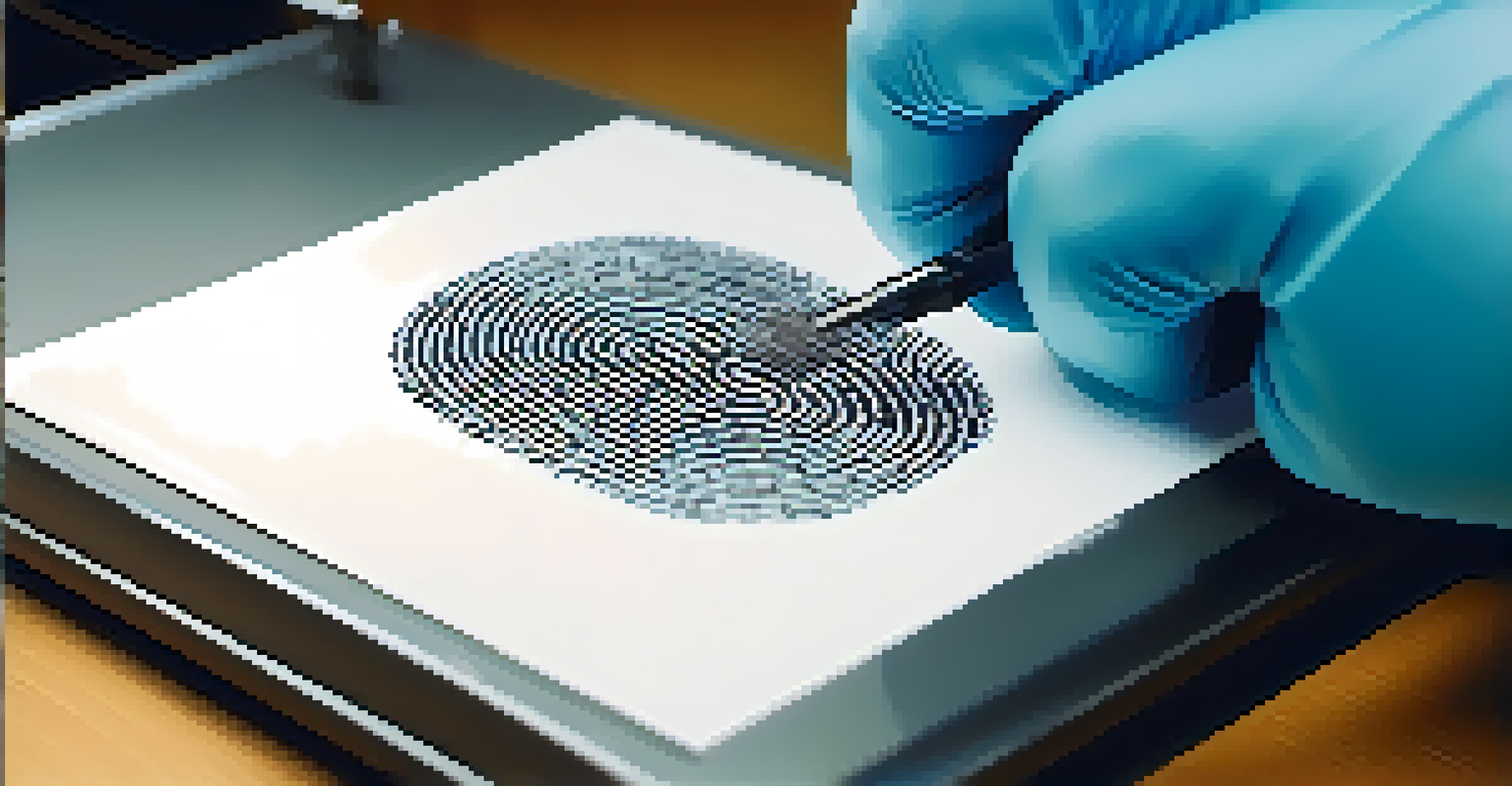Biometrics in Law Enforcement: Enhancing Crime Prevention

Understanding Biometrics: What It Is and How It Works
Biometrics refers to the measurement and statistical analysis of people's unique physical and behavioral characteristics. This technology can include anything from fingerprint scanning to facial recognition, and it plays a crucial role in identifying individuals accurately. In law enforcement, these tools can provide quick and reliable methods for verifying identities, which is essential in preventing crime and enhancing public safety.
Biometrics provides a reliable way to identify individuals, enhancing security and crime prevention.
The technology works by capturing biological data and comparing it to stored information in databases. For example, when a police officer scans a suspect's fingerprint, the system checks it against millions of records to find a match. This rapid verification helps law enforcement respond promptly to potential threats or criminal activities.
Biometrics are not only about security; they also enhance the efficiency of police work. With the ability to quickly identify individuals, officers can focus their efforts on areas where they can make the most impact, streamlining investigations and improving overall crime prevention strategies.
The Role of Facial Recognition in Crime Prevention
Facial recognition technology is one of the most well-known applications of biometrics in law enforcement. It analyzes facial features and compares them against databases to identify individuals, which can be incredibly effective in crowded places like airports and stadiums. By quickly identifying potential suspects or missing persons, law enforcement can take immediate action to prevent crimes.

However, the use of facial recognition also raises concerns about privacy and civil liberties. Striking a balance between public safety and individual rights is crucial as agencies adopt this technology. Many jurisdictions are implementing strict regulations to ensure that facial recognition is used responsibly and ethically.
Biometrics Enhance Crime Prevention
Biometric technologies, including fingerprint, facial recognition, and DNA analysis, provide law enforcement with effective tools for quickly identifying and apprehending suspects.
Despite these challenges, the potential benefits of facial recognition in crime prevention are significant. When used correctly, it can help officers apprehend suspects more efficiently and solve cases that might otherwise go cold, ultimately leading to safer communities.
How Fingerprint Analysis Strengthens Investigations
Fingerprint analysis has long been a staple in forensic science and law enforcement. Each person's fingerprints are unique, making them a reliable method for identifying individuals involved in criminal activities. By analyzing fingerprints found at crime scenes, investigators can link suspects to specific incidents, providing crucial evidence for cases.
As technology evolves, it's essential to balance innovation in biometrics with ethical considerations.
Modern advancements in fingerprint technology, such as automated fingerprint identification systems (AFIS), have dramatically improved the speed and accuracy of this process. These systems can compare a fingerprint collected at a crime scene against millions of records in seconds, significantly enhancing the chances of identifying a suspect quickly.
The reliability of fingerprint analysis not only aids in solving crimes but also acts as a deterrent for potential offenders. Knowing that their fingerprints could easily link them to a crime may discourage individuals from engaging in illegal activities in the first place.
The Use of DNA Biometrics in Solving Crimes
DNA biometrics is another powerful tool in law enforcement's arsenal for crime prevention. Analyzing DNA samples collected from crime scenes can provide definitive evidence linking a suspect to a specific crime. This method has solved many cold cases and provided closure to victims' families, showcasing the importance of genetic evidence in criminal investigations.
With the advancements in DNA sequencing technology, police can now obtain results faster than ever before. This rapid processing means that law enforcement can act quickly on leads and potentially prevent further crimes by apprehending suspects before they can strike again.
Ethical Concerns Must Be Addressed
While biometrics offer significant advantages, issues related to privacy, data security, and potential misuse require careful navigation to maintain public trust.
However, the use of DNA raises ethical considerations regarding privacy and data management. It is essential for law enforcement agencies to follow strict protocols to ensure that DNA data is handled responsibly and that individuals' rights are protected.
The Impact of Biometric Databases on Crime Prevention
Biometric databases are crucial for the effective use of biometric technology in law enforcement. These systems store vast amounts of biometric data, including fingerprints, DNA profiles, and facial images, allowing for quick access when needed. The ability to cross-reference data from various sources can significantly enhance the chances of solving crimes and preventing future incidents.
However, the establishment and maintenance of these databases come with challenges, including ensuring data security and protecting against unauthorized access. Law enforcement agencies must invest in robust cybersecurity measures to safeguard sensitive information while maintaining public trust.
When used effectively, biometric databases can lead to significant reductions in crime rates. By providing law enforcement with the tools to identify and apprehend offenders swiftly, these systems not only enhance public safety but also promote a more proactive approach to crime prevention.
Challenges and Concerns Surrounding Biometrics in Law Enforcement
While biometrics presents numerous advantages for law enforcement, it also comes with challenges and concerns. Issues such as privacy invasion, data security, and potential misuse of technology can raise significant ethical questions. Law enforcement agencies need to navigate these concerns carefully to maintain public trust while leveraging the benefits of biometrics.
Moreover, there are concerns about the accuracy of biometric systems. False positives can lead to wrongful accusations, undermining the very purpose of these technologies. Continuous improvements and regular audits of biometric systems are essential to ensure their reliability and fairness.
Future Innovations in Biometrics
Emerging technologies like iris recognition and AI integration promise to further improve the efficiency and effectiveness of biometric systems in law enforcement.
Public engagement is crucial in addressing these challenges. By fostering open discussions about the implications of biometrics in law enforcement, agencies can work towards creating transparent policies that prioritize both safety and individual rights.
The Future of Biometrics in Law Enforcement
As technology continues to evolve, the future of biometrics in law enforcement looks promising. Emerging technologies such as iris recognition and gait analysis are on the horizon, potentially providing even more reliable identification methods. These advancements could further enhance crime prevention strategies and improve the efficiency of law enforcement agencies.
Moreover, the integration of artificial intelligence (AI) with biometric systems could revolutionize how law enforcement operates. AI can analyze patterns and trends in biometric data, helping officers anticipate criminal activity and allocate resources effectively.

Ultimately, the future of biometrics in law enforcement hinges on balancing innovation with ethical considerations. By prioritizing responsible use and transparency, law enforcement can harness the full potential of biometrics to create safer communities while respecting individual rights.